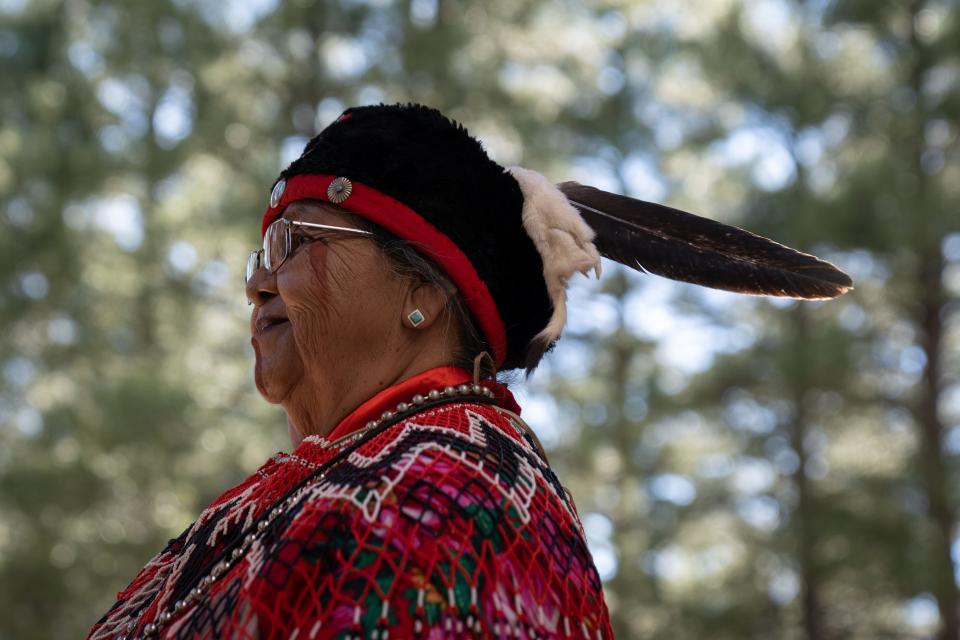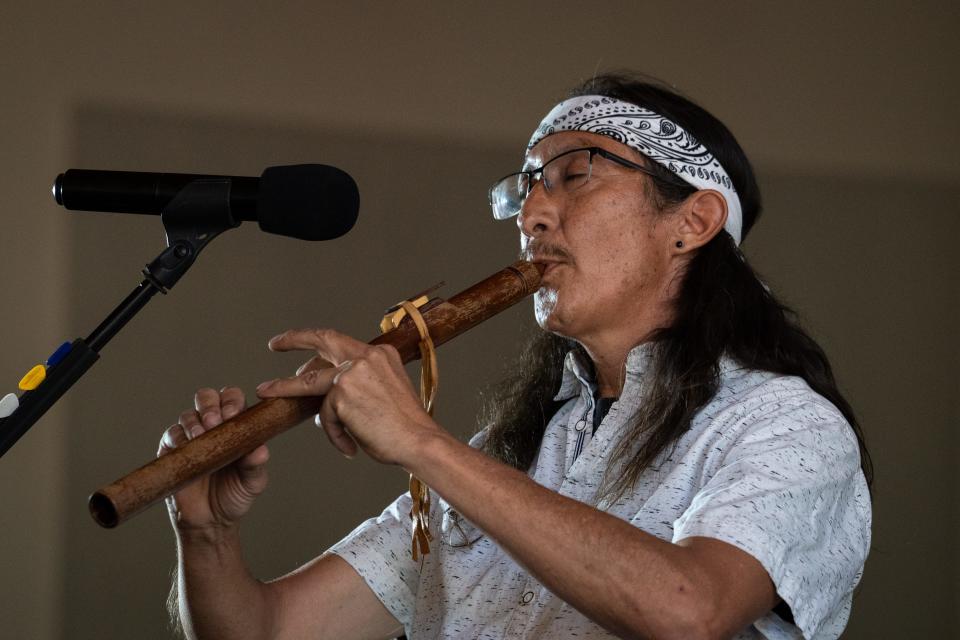'A sacred place': Advocates for new Grand Canyon protections rally in hopes Biden will act
- Oops!Something went wrong.Please try again later.
GRAND CANYON NATIONAL PARK – Native American advocates for Grand Canyon land and water protections sang, danced and celebrated their spiritual connections to the canyon on Saturday ahead of a presidential visit this week that they hope will culminate in the designation of a 1.1 million-acre national monument beyond the park’s boundaries.
President Joe Biden plans to tour the Southwest, including Arizona, this week. Hopes are high among tribal and environmental advocates that the president will use this occasion to create the proposed Baaj Nwaavjo I'tah Kukveni Grand Canyon National Monument on federal lands north and south of the Grand Canyon. Others, especially local officials in northwest Arizona, oppose the prospect.
The advocates’ ultimate hope is that the monument, for which the government is expected to partner with tribes on management, will make permanent a 20-year moratorium on new uranium mining claims that the Obama administration imposed in 2012.
“We have to do something,” Havasupai Tribal Councilwoman Dianna Sue White Dove Uqualla told The Arizona Republic after addressing a crowd of about 80 at the “Native Voices of the Canyon” event on Grand Canyon’s South Rim. “This land is a sacred place. Every place that you set foot, there’s a powerful connection to our elders and their spirits.”

Her tribe, known as the People of the Blue Green Water, is among several whose origin stories center on the canyon and the Colorado and Little Colorado rivers. They point to a legacy of poison and death left behind by open-pit uranium mines on Navajo lands that fueled the Cold War and fear new mines would contaminate aquifers whose waters emerge as springs in the Grand Canyon.
Uqualla said she fears for the rabbits that tribal members may eat and for the birds that come into contact with contamination, noting that a uranium mine operator in 2017 sought to evaporate water that infiltrated a mineshaft by spraying it in the air.
“It is not going to kill us like a gun,” she said. “It will keep haunting us from generation to generation, and in the end, we will not be human.”
The tribes and environmental groups have pressed for a new monument to cover Kaibab National Forest lands south of the Grand Canyon, plus lands administered by the U.S. Bureau of Land Management on the north side, east and west of the Kaibab forest lands there. Excitement has built in recent days, especially after the Washington Post reported on Friday that sources familiar with Biden’s thinking said he’s leaning toward using his Antiquities Act power to designate the monument. The White House did not respond to questions from The Republic, but some Arizona officials also suggested a designation may be imminent.
Here's what to know: Proposed Grand Canyon monument could turn 1.1 million acres into protected land
“We anticipate that the president and the administration will designate the Grand Canyon as a national monument, and do so in accordance with the legislation that I introduced,” U.S. Sen. Kyrsten Sinema, I-Ariz., told The Republic on Wednesday. “I hope to hear good news on this as soon as next week.”
The legislation, also supported by Sen. Mark Kelly, D-Ariz., envisions tribal participation in the monument’s management. Rep. Raul Grijalva, D-Ariz., has backed one form or another of the monument for years. The land’s cultural significance to tribes is a major rationale for monument status.
The Mohave County government of northwest Arizona, backed by U.S. Rep. Paul Gosar, R-Ariz., opposes the monument. Much of the proposed protections would be in Coconino County, which has long supported the uranium moratorium. But Mohave County Supervisor Travis Lingenfelter said 445,000 acres of it would be in his district west of the North Rim and the Kaibab Plateau. There, he said, it could hinder economic development options for Colorado City, a fundamentalist religious community that has long been isolated — but has been working to engage with the rest of the county and state.
Mohave County supports protections for tribal sacred sites, he said, but not across a broad landscape that is supposed to be managed for the benefit of all Americans. “You can’t tell me that 445,000 acres of rangeland is culturally sensitive,” he said.
Lingenfelter was angered by the administration’s failure to conduct a public hearing in his county. Republican state lawmakers will hold their own hearing at 5 p.m. on Monday at the county offices in Kingman. At this point, though, Lingenfelter said it may be up to voters to hold accountable Arizona officials who go along with the president.
“We believe that there’s a strong possibility, because of the way the BLM has been ignoring our requests and our calls — and the fact that we’ve been omitted from their public policy discussions — that they’re going to move on this monument.”
One uranium mine operating but not currently producing ore on the would-be monument’s southern section would be grandfathered in, allowing it to proceed with plans to dig and truck uranium to a mill in southeastern Utah. Hundreds of other existing claims theoretically could move forward as well but would require evaluations to determine if they’re economically viable and valid under federal law. No new claims have been staked during the moratorium, and none could be staked under a monument.
Uranium mining: Senate approves expanding compensation for Navajo Nation uranium miners, downwinders
A spokesman for Energy Fuels, the company that operates the Pinyon Plain Mine, formerly known as Canyon Mine — the same one Uqualla feared had contaminated wildlife — said there’s no need for a monument to protect Grand Canyon waters.
“There is zero scientific evidence that uranium mining on the lands covered by the proposed national monument has ever had any adverse effects on human health, groundwater, the Grand Canyon, or the environment,” spokesman Curtis Moore said in an emailed response to questions. “So, we believe a monument is unnecessary.”
It’s understandable that tribes including Navajo and Hopi, who have suffered contamination from past mining practices, should be skeptical of the industry, Moore said. But current mining methods are safer than the old pits left behind in the mid-20th century, he said.
“Activist groups like the Sierra Club, Grand Canyon Trust, and others are happy to exploit this distrust to advance their anti-nuclear political agendas,” Moore said.
Grand Canyon Trust responded that the tribes have led monument advocacy for years and with good reason.
“The tribes have been working to stop uranium mining around Grand Canyon since long before environmental groups got involved,” said Amber Reimondo, the Trust’s director of energy programs. “The tribes themselves have experienced the negative impacts of uranium extraction.
Both Reimondo and Sierra Club Grand Canyon Program Manager Alicyn Gitlin challenged the company’s assertion that there’s no threat to waters that surface in the Grand Canyon. The lack of information about existing contamination is due to a dearth of sampling wells or federal funds for monitoring, they said. The fractured geology south of the Grand Canyon makes it hard to know where to look.
“We really don’t know how water moves below the (Pinyon Plain) mine,” said Gitlin, who helped coordinate Saturday’s event. “We’re out here because the tribes are fearful for their water source.”
Hopi and Tewa musician-activist Ed Kabotie emceed the event, the first of several that his band, Tha 'Yoties, intends to stage around the country before an October engagement at Washington’s Smithsonian Museum of the American Indian. He shared the stage with a Hopi dance troupe and screenings of three films about Native connections to the canyon. The tour, called “Howlin’ for the Homelands,” is intended to support monument designation, but Kabotie said he’ll be happiest if it turns into a celebration after this week.

“The establishment of a monument is a very important thing to our people,” he said. “It’s giving protection to the lands, giving protection to its medicines. As a co-managed monument, it’s honoring our heritage.”
A new monument won’t instantly solve problems created by more than a century of displacement from the national park or the abuses of the land, he said, emphasizing that hundreds of uranium pits on Navajo land still await cleanup. He hopes for a new land-management vision that leads with the heart as well as the mind and leaves behind extractive industries that support economies elsewhere.
“We’re howling for the indigenous people and lands of the Colorado Plateau,” Kabotie said. “The issues are all interconnected because the waters are all interconnected.”
The message resonated with tourists who assemble to watch and listen on Saturday. Rut Garcia, on a road trip with her family from North Lauderdale, Florida, said she appreciated exposing her 8- and 9-year-old children to the songs, dances and films.
“We were able to see how the different tribes see the Grand Canyon and their feelings,” Garcia said. “It should be as protected as possible. If that’s what the monument means, I’m definitely supportive.”
The Republic's Debra Utacia Krol contributed reporting.
Brandon Loomis covers environmental and climate issues for The Arizona Republic and azcentral.com. Reach him at brandon.loomis@arizonarepublic.com or follow on Twitter @brandonloomis.
Environmental coverage on azcentral.com and in The Arizona Republic is supported by a grant from the Nina Mason Pulliam Charitable Trust. Follow The Republic environmental reporting team at environment.azcentral.com and @azcenvironment on Facebook, Twitter and Instagram.
You can support environmental journalism in Arizona by subscribing to azcentral.com today
This article originally appeared on Arizona Republic: A proposed monument could halt new uranium claims around Grand Canyon

